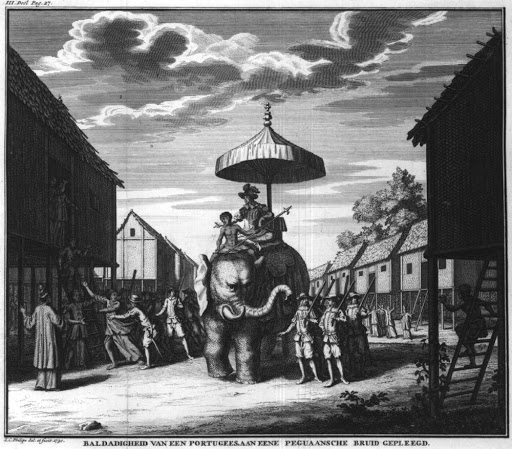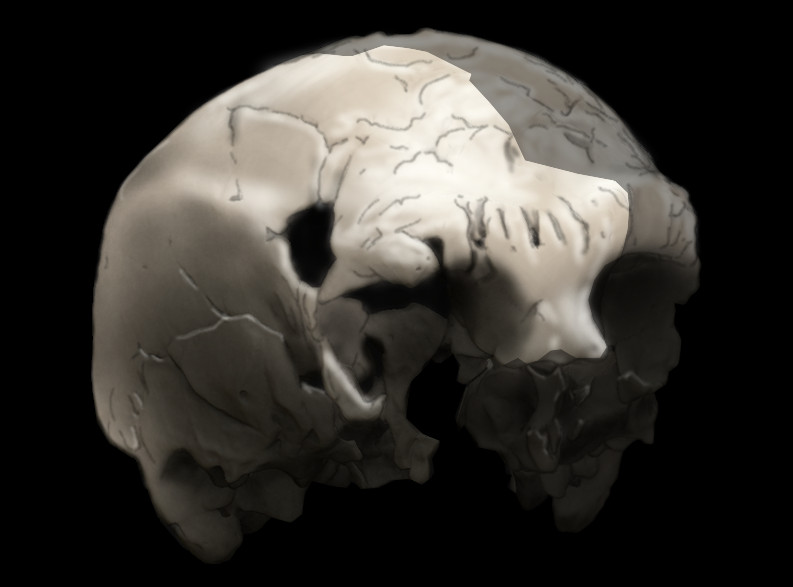|
Great Bell Of Dhammazedi
The Great Bell of Dhammazedi ( ) was a bronze bell, believed to be the largest bell ever cast. It was cast on 5 February 1484 by order of King Dhammazedi of Hanthawaddy Pegu, and presented to the Shwedagon Pagoda of Dagon (today's Yangon, Myanmar). Description In 1484, King Dhammazedi's astrologer advised him to postpone casting of the bell, because it was at the inauspicious time of the Crocodile constellation, and he predicted the bell would not produce any sound. After the bell was completed, it reportedly had an unpleasant tone. According to contemporary texts, the bell was cast from 180,000 viss (294 t) of metal which included silver and gold, as well as copper and tin. It was said to be twelve cubits high and eight cubits wide. In 1583, Gasparo Balbi, a italian gem merchant, visited the Shwedagon Pagoda and described the King Dhammazedi Bell in his diary as being engraved from top to bottom with writing that he could not decipher: Theft from Shwedagon Pago ... [...More Info...] [...Related Items...] OR: [Wikipedia] [Google] [Baidu] |
Gasparo Balbi
Gasparo Balbi was an Italian jeweller, merchant, and author from Venice, who is best known for his account of his travels to India and the East from 1579 to 1588. He mainly travelled with Portuguese merchant and naval vessels and to forts and trading posts owned by or friendly to that country's commerce. His story, published in 1590 in Venice, was titled ''Voyage to the Oriental Indies''. Itinerary His travels began in Cyprus, whence he moved to Aleppo, then to Babylon and Basra, and finally to the Portuguese fort of Hormuz. From there, he embarked over water past the Portuguese fort of Dibba ( Debe), to the post at Diu, from there to Daman and then to the walled city of Chiauul ( Chaul), then Goa, then Cocchi, through Cananor ( Cannanore) and Onor. He then went to Negapatan (Nagapattinam), then to São Tomé and then to Pegu. He then visited Dala, Dogon and the ruins of Sirian (Syriam), Meccao, and Silon. He went then to Maraban, Malacca. and from there to Cocchi (Kingdom ... [...More Info...] [...Related Items...] OR: [Wikipedia] [Google] [Baidu] |
Aires De Saldanha
Aires de Saldanha (Santarém, Portugal, 10 May 1542 - Terceira, 19 August 1605) was a Portuguese soldier. He was the son of António de Saldanha, military and navigator who discovered the bay of Saldanha. He went to Portuguese India in 1558, with the viceroy Constantino of Braganza, this time serving for twelve years in the region. Captain and Governor He returned to Portugal in 1570, where he married Joana de Albuquerque, soon after he returned to India, this time with the Viceroy Rui Lourenço de Távora. He was appointed captain of Portuguese Malacca, where he built the fort of Tidor. Returning to Portugal, he was appointed governor of Tangier, a position he held for 9 years. Viceroy In 1600, he was named 17th Viceroy of India and 34th Governor of India. During his viceroyalty, in addition to financial difficulties, had to struggle against the Dutch on several fronts, defending Cochim and Goa, and repel them in the Moluccas. Death He died during his return to Portuga ... [...More Info...] [...Related Items...] OR: [Wikipedia] [Google] [Baidu] |
Bago River
Bago River (; Pegu River) is a river of southern Myanmar. It flows through Bago and Yangon, joining the Yangon River south of downtown Yangon.Schellinger, Paul E. and Salkin, Robert M. (editors) (1996) "Bago (Myanmar)" ''International Dictionary of Historic Places: Asia and Oceania'' (volume 5) Fitzroy Dearborn Publishers, Chicago, pp. 60-65page 60 The source of the Bago river comes from many streams in the hills of the Pegu RangeSeekins, Donald M. (2006) ''Historical dictionary of Burma (Myanmar)'' Scarecrow Press, Lanham, Marylandpage 357 with the traditional choice for the source being Sinhnamaung Mountain in Letpadan Township. Modern hydrological surveys find streams further north in Phyu Township that feed into the Bago River Basin. The Bago River flows into Yangon Region meeting the Yangon River at Monkey Point, Botahtaung Township, below which the river is called the Yangon River. In 1608, the Portuguese mercenary Filipe de Brito e Nicote, known as Nga Zinka to ... [...More Info...] [...Related Items...] OR: [Wikipedia] [Google] [Baidu] |
Rakhine State
Rakhine State ( ; , ; ), formerly known as Arakan State, is a Administrative divisions of Myanmar, state in Myanmar (Burma). Situated on the western coast, it is bordered by Chin State to the north, Magway Region, Bago Region and Ayeyarwady Region to the east, the Bay of Bengal to the west and the Chittagong Division, Chattogram Division of Bangladesh to the northwest. It is located approximately between latitudes 17°30' north and 21°30' north and longitudes 92°10' east and 94°50' east. The north–south Arakan Mountains or Rakhine Yoma separate Rakhine State from central Myanmar. Off the coast of Rakhine State there are some fairly large islands such as Ramree Island, Ramree, Cheduba and Myingun Island, Myingun. Rakhine State has an area of and its capital is Sittwe (formerly known as Akyab). Names The state was historically known as Arakan in English until the Burmese government adopted the English name Rakhine in 1989. History The history of the region of Arakan ... [...More Info...] [...Related Items...] OR: [Wikipedia] [Google] [Baidu] |
Bago, Burma
Bago (formerly spelled Pegu; , ), formerly known as Hanthawaddy, is a city and the capital of the Bago Region in Myanmar. It is located north-east of Yangon. Etymology The Burmese name Bago (ပဲခူး) is likely derived from the Mon language place name Bagaw (, ). Until the Burmese government renamed English place names throughout the country in 1989, Bago was known as Pegu. Bago was formerly known as Hanthawaddy (; ; ; lit. "she who possesses the sheldrake"), the name of a Burmese-Mon kingdom. An alternative etymology from the 1947 Burmese Encyclopedia derives Bago (ပဲခူး) from Wanpeku () as a shortening of Where the Hinthawan Ducks Graze (). This etymology relies on the non-phonetic Burmese spelling as its main reasoning. History Establishment Various Mon language chronicles report widely divergent foundation dates of Bago, ranging from 573 CE to 1152 CEA version of the 18th century chronicle '' Slapat Rajawan'' as reported by Arthur Pha ... [...More Info...] [...Related Items...] OR: [Wikipedia] [Google] [Baidu] |
Taungoo Dynasty
''taungnguumainn saat'' , conventional_long_name = Toungoo dynasty , common_name = Taungoo dynasty , status = Empire/ Kingdom , event_start = Independence from Ava Kingdom , year_start = 1510 , date_start = 16 October , event_end = Hanthawaddy conquest , year_end = 1752 , date_end = 23 March , event_pre = , date_pre = 1485 , event1 = , date_event1 = 1510–1599 , event2 = , date_event2 = 1599–1752 , p1 = Kingdom of Ava , p2 = Hanthawaddy Kingdom , p3 = Confederation of Shan States , p4 = Lan Na Kingdom , p5 = Ayutthaya Kingdom , p6 = Lan Xang , p7 = Manipur (kingdom) , s1 = Restored Hanthawaddy Kingdom , s2 ... [...More Info...] [...Related Items...] OR: [Wikipedia] [Google] [Baidu] |
Thanlyin
Thanlyin (; or ; , ; formerly Syriam) is a major port city of Myanmar, located across Bago River from the city of Yangon. Thanlyin comprises 17 quarters. It surrounding Thanlyin Township is home to the largest port in the country, Thilawa port, as well as the Thilawa Special Economic Zone and various prominent universities. History Thanlyin became a prominent port city in during the Hanthawaddy Kingdom when the port of Bago became silted in the 15th century. In 1599, the city was conquered by the Kingdom of Mrauk U's Portuguese mercenaries. The leader of the mercenaries Filipe de Brito e Nicotewas made governor of the city. However, in 1603, De Brito declared independence and. after defeating the invading Arakanese navy in 1604 and 1605, successfully established Portuguese rule over Syriam (or Sirião in Portuguese) under the Portuguese viceroy of Goa. 10 years later, Anaukpetlun of the restored Taungoo Dynasty retook the city, and executed de Brito by impalement. Thanl ... [...More Info...] [...Related Items...] OR: [Wikipedia] [Google] [Baidu] |
Mercenary
A mercenary is a private individual who joins an armed conflict for personal profit, is otherwise an outsider to the conflict, and is not a member of any other official military. Mercenaries fight for money or other forms of payment rather than for political interests. Beginning in the 20th century, mercenaries have increasingly come to be seen as less entitled to protection by rules of war than non-mercenaries. The Geneva Conventions declare that mercenaries are not recognized as legitimate combatants and do not have to be granted the same legal protections as captured service personnel of the armed forces. In practice, whether or not a person is a mercenary may be a matter of degree, as financial and political interests may overlap. International and national laws of war Protocol Additional GC 1977 (APGC77) is a 1977 amendment protocol to the Geneva Conventions. Article 47 of the protocol provides the most widely accepted international definition of a mercenary, th ... [...More Info...] [...Related Items...] OR: [Wikipedia] [Google] [Baidu] |
Portuguese People
The Portuguese people ( – masculine – or ''Portuguesas'') are a Romance languages, Romance-speaking ethnic group and nation Ethnic groups in Europe, indigenous to Portugal, a country that occupies the west side of the Iberian Peninsula in Southern Europe, south-west Europe, who share Culture of Portugal, culture, ancestry and Portuguese language, language. The Portuguese state began with the founding of the County of Portugal in 868. Following the Battle of São Mamede (1128), Portugal gained international recognition as a Kingdom of Portugal, kingdom through the Treaty of Zamora and the papal bull Manifestis Probatum. This Portuguese state paved the way for the Portuguese people to unite as a nation. The Portuguese Portuguese maritime exploration, explored Hic sunt Dracones, distant lands previously unknown to Europeans—in the Americas, Africa, Asia and Oceania (southwest Pacific Ocean). In 1415, with the conquest of Ceuta, the Portuguese took a significant role in the ... [...More Info...] [...Related Items...] OR: [Wikipedia] [Google] [Baidu] |
Philip De Brito
Filipe de Brito e Nicote or Nga Zinga (, ; c. 1566 – April 1613) was a Portuguese adventurer and mercenary in the service of the Arakanese kingdom of Mrauk U, and later of the Siamese Kingdom of Ayutthaya.Rajanubhab, D., 2001, Our Wars With the Burmese, Bangkok: White Lotus Co. Ltd., His name is also recorded with the French spelling Philippe de Brito. Biography Born to a French father in Lisbon, Portugal, de Brito first travelled to Southeast Asia as a cabin boy. He eventually served under Min Razagyi, King of Arakan and became governor of Syriam (now Thanlyin) in 1599, commanding 3 frigates and 3000 men. He encouraged more Portuguese to settle in Syriam (see Bayingyi) and constructed forts for defence, eventually seizing control and announcing his independence from Arakan in 1603. He captured Min Khamaung, crown prince of Arakan, when Toungoo and Arakan attacked in the 1605 Syriam battles, keeping him hostage until granted independence. De Brito then married the d ... [...More Info...] [...Related Items...] OR: [Wikipedia] [Google] [Baidu] |




